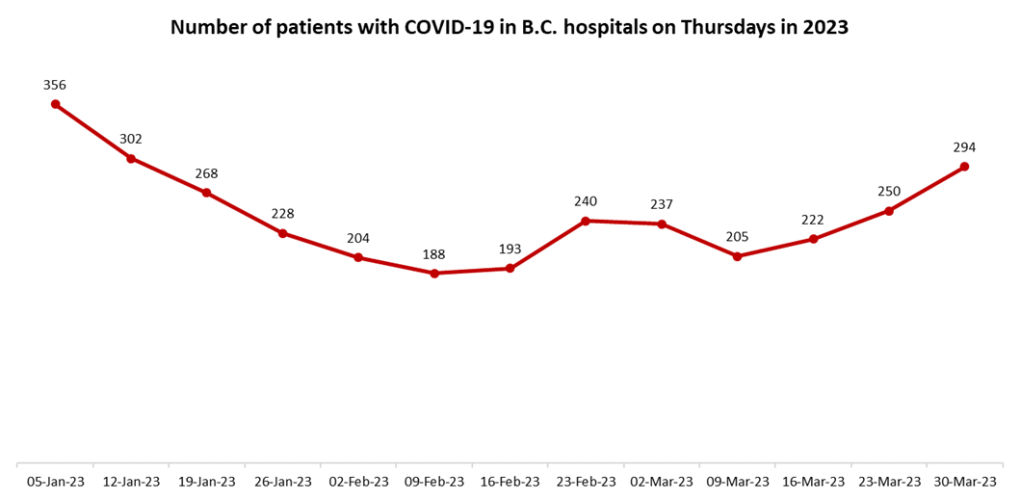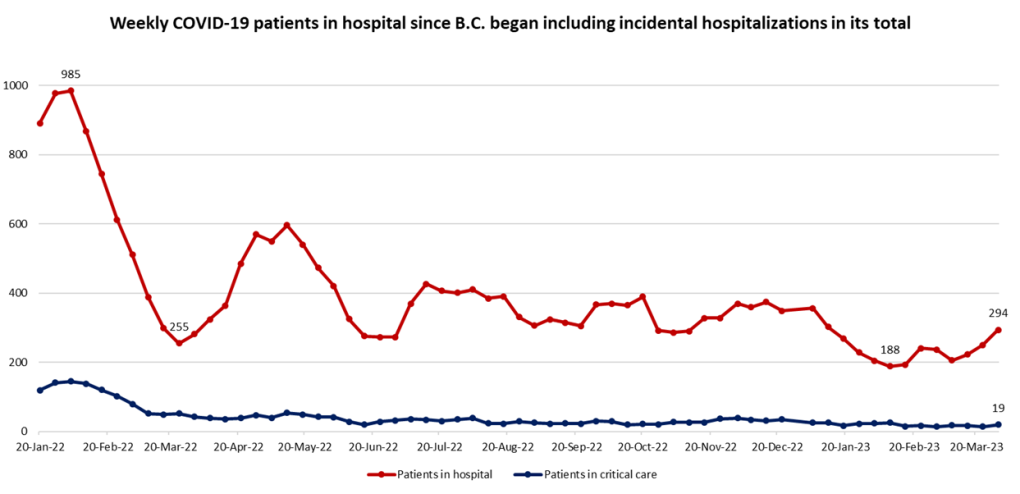B.C. COVID-19 data suggests increasing transmission

Indicators of the spread of COVID-19 in B.C. continued their upward trend this week, with the number of people hospitalized with the disease hitting its highest level since Jan. 12.
There were 294 people in hospital with the coronavirus in B.C. as of Thursday, up from 250 last week, an increase of nearly 18 per cent.
 The number of people in B.C. hospitals with COVID-19 in 2023 is shown. (CTV)
The number of people in B.C. hospitals with COVID-19 in 2023 is shown. (CTV)
The growth in the hospital population matches recent trends in other indicators, including the official case count and wastewater surveillance data.
The number of people currently in hospital with COVID-19 – sometimes called the hospital census – includes both those with serious cases of the disease requiring medical care and those who are hospitalized for other reasons and test positive incidentally.
Health officials have said between 40 and 50 per cent of those in hospital at any given time are there because of COVID-19, rather than for some other reason, meaning the majority of hospitalizations are incidental.
The 294 people in B.C. hospitals this week represent the third-highest total the province has seen on a Thursday so far this year.
Relative to 2022, however, when the hospital census rose as high as 985 and rarely dropped below 300, hospitalizations are still fairly low in B.C.
 The number of people in B.C. hospitals with COVID-19 on Thursdays since the province switched to a "hospital census" model in January 2022 is shown. (CTV)
The number of people in B.C. hospitals with COVID-19 on Thursdays since the province switched to a "hospital census" model in January 2022 is shown. (CTV)
OTHER DATA
Just how high the current wave of infections will rise is difficult to predict, but the available indicators do not yet show any signs of slowing down.
The B.C. Centre for Disease Control reported Thursday that 456 new, lab-confirmed cases of COVID-19 had been detected during the epidemiological week of March 19 to 25.
That's an increase from the 405 new cases reported last week for the period of March 11 to 18.
Similarly, the BCCDC reported 135 new hospital admissions during the week of March 19 to 25, up from 105 initially reported for the week before.
Both of these metrics – the official case count and new hospitalizations – come with notable caveats, but each one continues to move in a direction that suggests rising transmission of COVID-19.
The official case count is limited because it only includes infections confirmed through lab-based testing, which is not available to the vast majority of B.C. residents. The official count also excludes reinfections.
New hospital admission figures are limited because they are incomplete when the BCCDC first reports them. Last week's total of 105 new hospitalizations for the period of March 11 to 18 has but updated in this week's report to 143. This week's total of 135 for the period of March 19 to 25 will similarly see an increase when next week's data is released.
WASTEWATER
To supplement its other data, the BCCDC also monitors concentrations of the coronavirus in wastewater across the Lower Mainland and in several communities in the Interior and on Vancouver Island.
Throughout March, wastewater surveillance has shown rising levels of SARS-CoV-2 at every monitored treatment plant.
Last week, the BCCDC announced for the first time that it had begun using a more sensitive test on Feb. 28.
This week, the agency updated its wastewater surveillance data to remove trendlines, citing uncertainty caused by the change in testing methods as the reason. It says the removal of trendlines is temporary.
"(The new test) is more efficient and more sensitive, meaning it can yield a higher test result even if viral levels have not changed," a statement on the BCCDC wastewater surveillance page reads.
"Therefore, observed increases in viral concentrations in wastewater since the beginning of March are likely due, at least in part, to this new test. Trend analysis and interpretation are influenced as a result."
The agency says it is "retesting archived samples" to evaluate the impact the change in testing method has had on the data.
"BCCDC acknowledges that the public and health-care partners use wastewater data to understand how SARS-CoV-2 is spreading in B.C. and to assess their risk of infection," the statement continues. "We anticipate next week’s wastewater update will describe how the change in test affected trends and recent results."
CTVNews.ca Top Stories

Budget 2024 'likely to be the worst' in decades, former BoC governor says
Without having seen it, former Bank of Canada governor David Dodge believes that Tuesday's 2024 federal budget from Deputy Prime Minister and Finance Minister Chrystia Freeland is 'likely to be the worst budget' in decades.
What's at stake for Canada after Iran's unprecedented attack on Israel
Following the Iranian missile and drone strikes against Israel over the weekend, Canada should take the threat of Iran and potential escalation of the conflict seriously, one global affairs analyst says.
Former B.C. school trustee's 'strip-tease artist' remark was defamatory, judge rules
A controversial former school trustee from B.C.'s Fraser Valley who described a political rival as a "strip-tease artist" during an election campaign has been ordered to pay her $45,000 for defamation.
'A sense of urgency': Sask. man accused of abducting daughter calls himself to the stand during trial
Michael Gordon Jackson, the man on trial after being charged with contravention of a custody order for allegedly abducting his daughter in late 2021 to prevent her from getting a COVID-19 vaccine, called himself to the stand Monday.
Kingston, Ont.'s Aaliyah Edwards drafted into WNBA
After four years at the University of Connecticut, Edwards was selected sixth overall by the Washington Mystics in the WNBA draft Monday night.
NASA confirms mystery object that crashed through roof of Florida home came from space station
NASA confirmed Monday that a mystery object that crashed through the roof of a Florida home last month was a chunk of space junk from equipment discarded at the International Space Station.
A knife attack in Australia against a bishop and a priest is being treated as terrorism, police say
Horrified worshippers watched online and in person as a bishop was stabbed at the altar during a church service in Sydney on Sunday evening.
Body of 14-year-old boy pulled from Lake Ontario, police say he drowned while swimming
The body of a 14-year-old boy has been pulled from Lake Ontario after police say he drowned while swimming near Ashbridges Bay Park on Sunday night.
'Rust' armourer gets 18 months in prison for fatal shooting by Alec Baldwin on set
A movie weapons supervisor was sentenced to 18 months in prison in the fatal shooting of a cinematographer by Alec Baldwin on the set of 'Rust.'
































